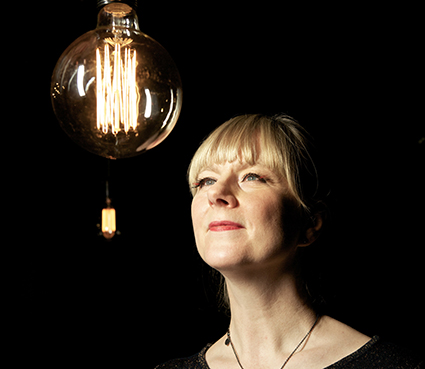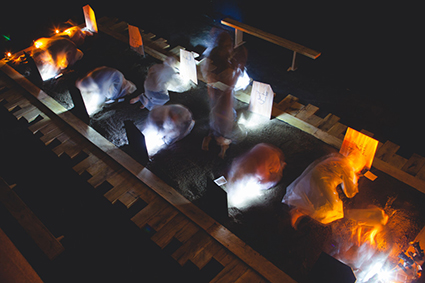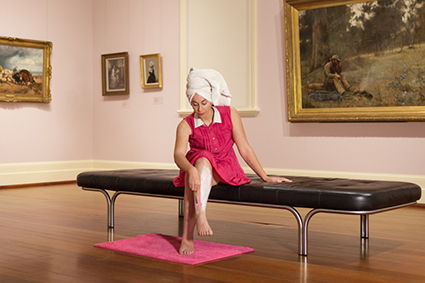One-on-one: truly, urgently present
Interviews Helen Cole, Robert Cook: Proximity Festival

Helen Cole
photo courtesy In Between Time
Helen Cole
Life is full of the most fundamental of encounters—the one-on-one experiences that shape us in the interplay between our estimation of self and our reckoning of how we are perceived by one another (and then the others). It’s a life-long loop of re-calibration unless our egos lock down in self-defence. When we gaze through the fourth wall of performance we principally see ourselves as observers, but art can address, seduce, implicate or chastise us even as we sit among hundreds of others. The affects can be deeply personal, even visceral, when a work tellingly ‘hits a nerve,’ ‘packs a punch’ or ‘goes for the jugular’ or you find yourself ‘moved to tears’ or ‘laugh yourself sick.’ One-on-one performance can trigger the same but its intimacy, its openness to any discipline or craft or subject and its freedom from established formulae means that it can surprise and enlighten in the most unexpected ways, as Helen Cole—a leading UK live art producer and Artistic Director/CEO of the renowned In Between Time festival of live art and contemporary performance in Bristol—told RealTime.
Cole is the special guest of the 2015 Proximity Festival in Perth, conducting a three-day masterclass titled For You Or With You, Not To You Or At You and a one-day workshop, Dear City, Together We Will Imagine. We asked her about the experiences and ideas she’d be drawing on and bringing to Proximity for the masterclass. We also asked if live art had changed over the time she’s engaged with it.
Helen Cole: masterclass
Some time ago in a one-to-one performance I was asked to write a letter to my future self. I was told this letter would be sent back to me in 5 years time. I pitched myself forward and imagined where I would be. I imagined what I could give and what I should expect in return. I couldn’t do it, didn’t want to pin myself down. As Joe Strummer of The Clash said, “The future is unwritten.” I sent myself a blank page.
The masterclass is a blank page that will evolve in the face of the people who sign up. It is a collaboration between myself, PVI Collective and Proximity Festival. Responding to the context of Proximity Festival, we will use the rules and terrain of the one-to-one.
Over the years, many of my seminal performance experiences have involved just two people: myself and the artist. The performances happen numerous times, repeated with different people, but each performance is unique. I’ve been offered freshly baked bread laced with the artist’s blood, gently cut a small incision in the skin on the back of another with a sharp surgical blade, I have had my feet washed, my nails decorated with iconic women’s faces, my hand placed on another’s heart. I have been sung to so closely that I have seen right down the artist’s throat. I have been shackled and hooded. I have danced with a bear. I have been lost in darkness and had stories whispered to me. I have been adorned with incredible jewellery, danced with a stranger, been fed strawberries and pearls and sent up a tree alone in a forest to see the world through its canopy. I have been lulled asleep in a bed at the foot of an immense statue of Queen Victoria. I have been immersed in a rain curtain, enveloped by sound in an anechoic chamber, watched a man run out of breath. I have been made to feel lonely, fearful, tested, overwhelmed, maternal, claustrophobic, delighted, safe, uncertain, tearful and in love.
Like any one-on-one performance, the masterclass is open and alert to the possibilities that its participants offer. It will explore intimacy, participatory exchanges, networked performance, digital platforms, public space, game-play. We will develop manifestos getting to the essence of why we do what we do. We will exercise agency and require courage and trust. We will explore ideas together and test assumptions without compromise. By the time we emerge we will have affected each other.
Live art’s power to change
I passionately believe in live art’s power to change. I have seen it happen so many times. In a woman bricked up behind a wall, a long string of autopsy threads, a blanket made from human hair, a gun repeatedly pointed at the audience, a fake moon, a line of women pissing down a wall, a library of bones, a fog bridge, a glass kiss.
Live art’s history and continuing evolution embraces the edges, and these edges keep on shifting. It is live art’s job to seek out and interrogate the margins of form, contexts and body; to go beyond category and containment; to be fearless in the face of unknowns. In doing so, live art is mobile and responsive in the face of new realities.
In 2015, our world is uncertain, in transit, in crisis, in pain. At In Between Time, we cannot ignore this truth and neither can the artists with whom we work. The world is screaming and we are screaming too.
As an international producer I am privileged: I travel, I meet artists and I see work. I am constantly thrown into the new. This is my job. But what do I do with this privilege? How do I use my power to rewrite, contest, decolonise? How do I blow apart my own privilege and open up spaces for others to come through?

Tania El Khoury, Gardens Speak
At Fierce Festival in Birmingham in 2014, I am dressed in white overalls and I am lying in the dark on cold earth. I have been searching for the name of a man I don’t know, a man I will never know, written in Arabic on a grave stone. I have found him and I dig with my hands. I dig until I uncover a speaker and I lie with my ear to the ground. I am told the story of this man and how he died. An ordinary life violently ended during the Syrian uprising against the Assad regime. In Syria, his home, he has no marked grave, as funerals are targets for further bombing, killing mourners, described as activists, because of the loved ones they have lost. So people are forced to bury their friends and family members secretly in their own gardens. No public naming, no marking, no place to mourn. Through this incredible work, Gardens Speak by the Lebanese artist Tania El Khoury, thousands of miles away from his home, this man has a voice. He has a grave. I am lying at it. His story is known to me. He was a grocer who was killed by shrapnel on the way to his shop one morning. He left a wife and small children still in hope for a better future. Through the work of El Khoury and his family this future gets just a small step closer. He is heard.
El Khoury’s work reminds me that Live Art can never ignore the context in which it finds itself. Live Art creates the conditions for shared knowledge and understanding, the combustion for new ideas. Art reminds us of this all the time. Live art at its best rubs our noses in it. Screaming right in our faces, it beautifully, seductively pierces our armour to remind us that, for this moment, we have agency, we can do something. We are truly, urgently present.
In 2015, Live art remains the space in which artists can be most angry, most beautiful in their deviance. It is the space in which we learn and tell the truth.
2015 Proximity Festival program
Featured artists in this year’s program are Chloe Flockart (WA), Monopolly (body part investment strategy consultation); Malcolm Whittaker (NSW), Once of Twice Daily (“a sensory gallery experience leaving you with a fresh aftertaste”); Mish Grigor (NSW), Sex Talk (from a family’s frank discussions); Jackson Eaton (VIC), Current Mood (self as selfie in the gallery); Tom Blake (WA), Micronational (build a State of You); Phillip Adams (VIC), After (A surreal encounter with the other with invited nudity); Mei Saraswati (WA), Meditations on Water (connect sonically with Perth’s wetlands); Caroline Garcia (NSW); Beings-unlike-us (“guided rituals from tribal Filipino spirituality”); Leon Ewing (WA), Raised by Brutalism (sonically “embrace the cold hard edges of architectural heritage”); Emily Parsons-Lord (NSW), You will always be wanted by me (“explore our connection to celestial astronomy”); Brett Smith (WA), When you’re here, I’m nowhere (“solo sound and light journey into the unknown”); and Jo Bannon (UK), Dead Line (“Take a moment to contemplate your mortality”).

Promotional image, Proximity Festival 2015
photo Matt Sav
Promotional image, Proximity Festival 2015
About Proximity Festival
Perth’s artist-led Proximity Festival was co-founded in 2011 by James Berlyn, Sarah Rowbottam and Kelli McCluskey to “provide critical peer support, encouraging artists from all disciplines to experiment with new modes of practice in the creation of participatory art” (website). One of Proximity’s goals is for each festival to occupy a venue and exploit its spaces—the Blue Room Theatre in 2012, Fremantle Arts Centre in 2014 and, for 2015, the Art Gallery of Western Australia. RealTime asked Robert Cook, curator of International Contemporary Art, to tell us why the gallery decided to partner the Proximity Festival and how ‘liveness’ fits the gallery ethos.
Robert Cook: Proximity, performance & AGWA
At the end of last year the Gallery released a document called the Essence of AGWA. It basically captured, in a very pared-down form, the aspirations of the institution, its board and its staff. A key aspect that came out of the discussions that lay behind it was a strong desire from all to connect, more fully and more authentically with the arts community around us. We understand that this is best done step by step, so that connections are engrained. In light of this, one strategy we enacted was the establishment of a WA Focus space that rotates four times a year. This responds directly to local practice and will continue to expand to include alternative visions and approaches to thinking about art and what it constitutes.
In terms of local projects that have been pushing boundaries (in this latter sense), a key initiative in our community is Proximity Festival. I was a member of the curatorium for the 2014 Festival held at Fremantle Arts Centre. This experience added to my respect for what they had achieved in the first two festivals. In particular, I was super impressed with how they approached their curation in relation to not just program development, but their care for artist development and individual performance outcomes. There was an amazing spirit behind the whole production and, anecdotally, I knew that artists involved were really happy with the project, but not just happy, happy in a critical sense, in that it pushed their practices in positive new ways. It expanded what was possible for them. That’s a perfect, sustainable approach. At the same time, our Director, Stefano Carboni had been looking with some considerable urgency actually, at getting performance into our program. Proximity was a neat fit.
In relation to the concept of ‘liveness,’ it is a simple fact that all galleries want liveliness in their buildings. We all yearn for buoyancy of engagement of real time activity, for art to be part of people’s living, in dialogue with their reflection (of course the split is not as straight as this implies). But beyond that, and this was Stefano’s main driver, it is an acknowledgement of the fact that the performative is a hugely significant part of contemporary visual culture and that we need to expand our approaches to properly present this work, and importantly to find ways for it to synthesise with the gallery’s other material.
This is a long term project and of course in saying this, the inclusion of Proximity is just a step. It’s been very useful though. Immersing ourselves in it, is helping us institutionally to open up to its challenges; it’s a terrific learning and growth opportunity. We’ve also initiated a permanent space for presenting moving image works. I should also say that, naturally, the gallery has some history with performance, for instance Edge of Desire: recent art from India (curated by Chaitanya Sambrani; 2004-5), featured performance works by Shilpa Gupta and NS Harsha.
Anyway, I think the key for us is that we want to find ways to open up to the reality of practice, that we see this as a long-term project, and that it is about growth for us; meaningful institutional change occurs gradually. This might frustrate some, but I think they’ll be surprised at where we get to over the next five years.
–
Proximity Festival 2015, curators Sarah Rowbottam, Kelli McCluskey, co-presented by the Art Gallery of Western Australia, Perth Cultural Centre, 28 Oct-8 Nov
RealTime issue #129 Oct-Nov 2015 pg. 8-9






